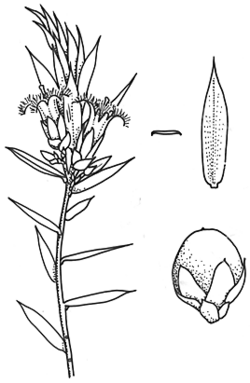Leucopogon fraseri A.Cunn. APNI* Synonyms: Leucopogon stuartii Sond. APNI*

Description: Prostrate shrub with branches ascending to 0.2 m high; branchlets bristly.
Leaves ± obovate, 4.5–8.1 mm long, 1.3–2.3 mm wide; margins flat or slightly recurved, toothed towards apex; lamina discolorous, glabrous, flat or lower surface slightly concave and with 3 ± central parallel veins and the others prominently diverging; petiole 0.3–0.5 mm long.
Flowers erect, 1 or 2 plus rudiment, white; peduncles c. 1 mm long; bracteoles 1.1–1.8 mm long. Sepals 2.5–3.9 mm long. Corolla tube 4–5 mm long, internally ± pilose; lobes 2.0–3.4 mm long.
Fruit broad-ellipsoid or ovoid, 4.7–5.3 mm long, glabrous, yellow when mature.
Flowering: September–November, sometimes March-May also.
Distribution and occurrence: Grows in shallow sandy soils, often poorly drained, or among rocks in dry sclerophyll forest, shrubland and heath on sandstone or granite commonly above c. 500 metres above sea level on the ranges of the northern and southern tablelands.
NSW subdivisions: SC, NT, CT, ST
Other Australian states: Vic. Tas.
Text by J. M. Powell, except for groups with contributors listed
Taxon concept: Flora of NSW 3 (1992)
ECOLOGY
Life History
Vegetative spread No (McIntyre et al. 1995).
Flowers White, September--November, sometimes March--May.
Fruit/seed Succulent fruit (drupe), yellow, 5 mm long.
Dispersal, establishment and growth Diaspore: fruit, adapted for dispersal by ingestion (McIntyre et al. 1995).
Habitat
Habitat Rocky areas, slopes.
Altitude 500--1000 m
Annual rainfall 600--1000 mm
Typical local abundance Occasional.
Vegetation Eucalypt woodland e.g. with Eucalyptus rossii, E. dives; shrubland and heath.
Substrate Shallow sandy soils, on sandstone or granite, low nutrients, often poorly drained.
APNI* Provides a link to the Australian Plant Name Index (hosted by the Australian National Botanic Gardens) for comprehensive bibliographic data
***The AVH map option provides a detailed interactive Australia wide distribution map drawn from collections held by all major Australian herbaria participating in the Australian Virtual Herbarium project.
|


